Trans World Airlines: Difference between revisions
No edit summary |
|||
| Line 142: | Line 142: | ||
===1940s=== |
===1940s=== |
||
====World War II==== |
====World War II==== |
||
Hughes gained a controlling interest in 1941 and eventually controlled 78 percent of TWA. The airline prospered during [[World War II]], racking up 40 million miles in flights for the Army, as well as supplying the North Atlantic route to [[Prestwick, Scotland]], and the South Atlantic route from [[Brazil]] to [[Liberia]] and points east. |
Hughes gained a controlling interest in 1941 and eventually controlled 78 percent of TWA. The airline prospered during [[World War II]], racking up 40 million miles in flights for the Army, as well as supplying the North Atlantic route to [[Prestwick, Scotland]], and the South Atlantic route from [[Brazil]] to [[Liberia]] and points east. He was asked to fly into European cities with high refugee concentrations outside active hostilities to perform rescues but he refused. In 1941, while filming a movie, Hughes felt that the camera did not do justice to Jane Russell's large bust. He employed his engineering skills to design a new cantilevered underwire bra. Hughes pushed for the construction of the Lockheed Constellation, which would become synonymous with the TWA style of elegance and cutting-edge technology. On April 17, 1944, Hughes and Frye flew the Constellation (C-69 USAAF #43-10310) from [[Burbank, California]], to [[Washington, D.C.]], in an unofficial record 6 hours 58 minutes. |
||
In 1939, Adolph "Al" Schwimmer began his aerospace career at Lockheed Martin as an engineer and also received his civilian pilot license. During World War II, he worked for TWA and assisted the U.S. Air Transport Command as a flight engineer. Holocaust survivors say he did a "heck of a job." |
|||
Hughes pushed for the construction of the Lockheed Constellation, which would become synonymous with the TWA style of elegance and cutting-edge technology. On April 17, 1944, Hughes and Frye flew the Constellation (C-69 USAAF #43-10310) from [[Burbank, California]], to [[Washington, D.C.]], in an unofficial record 6 hours 58 minutes. |
|||
====Post-war: The Trans World Airline==== |
====Post-war: The Trans World Airline==== |
||
Revision as of 23:04, 12 February 2012
This article needs additional citations for verification. (May 2009) |
 | |||||||
| |||||||
| Founded | 1925 (as Western Air Express) | ||||||
|---|---|---|---|---|---|---|---|
| Ceased operations | December 1, 2001 (Merged with American Airlines) | ||||||
| Hubs | |||||||
| Focus cities | |||||||
| Frequent-flyer program | Aviators, AAdvantage | ||||||
| Alliance | Oneworld (April–December 2001) | ||||||
| Fleet size | 190 | ||||||
| Destinations | 132 | ||||||
| Parent company | Transworld Corporation | ||||||
| Headquarters | List of headquarters
| ||||||
| Key people | List of key people
| ||||||
| Website | twa.com | ||||||
Trans World Airlines (TWA) was an American airline that existed from 1925 until it was bought out by and merged with American Airlines in 2001. It was a major domestic airline in the United States and the main U.S.-based competitor of Pan American World Airways (Pan Am) on intercontinental routes from 1946 until deregulation in the late 1970s. TWA had hubs in St. Louis and New York City (JFK) for much of its history, with focus cities in Kansas City, Los Angeles, and San Juan, Puerto Rico at times. In the 1980s it built up a hub in Atlanta, an operation which was reduced in the 1990s.
Flying to most major U.S. cities, TWA was one of the largest domestic airlines; before deregulation TWA, American Airlines, United Airlines, and Eastern Air Lines were collectively known as the "Big Four". It also had a substantial feeder operation from smaller cities in the Midwestern United States. Beyond the U.S., TWA had a large European and Middle Eastern network, served mainly from its hub, the iconic TWA Flight Center, at John F. Kennedy International Airport. For a few years its routes circumnavigated the globe. Along with Pan Am, it was considered to be a secondary unofficial flag carrier for the United States, especially after Pan Am was dissolved in the early 1990s.[3][4][5]
History
1930s
Founding—TWA

TWA's corporate history dates from the July 16, 1930, forced merger of Transcontinental Air Transport (T-A-T) and Western Air Express to form Transcontinental & Western Air (T&WA).[6] The companies merged at the urging of Postmaster General Walter Folger Brown, who was looking for bigger airlines to give airmail contracts.
Both airlines brought high-profile aviation pioneers who would give the airline the panache of being called "The Airline Run by Flyers." The airlines would be known for several years as being on the cutting edge of aviation. Transcontinental, the bigger of the two, had the marquee expertise of Charles Lindbergh and was already offering a 48-hour combination of plane and train trip across the United States. Western, which was slightly older having been founded in 1925, had the expertise of Jack Frye.
On October 25, 1930, the airline offered one of the first all-plane scheduled service from coast to coast: the Lindbergh Route. The route took 36 hours and initially called for overnights in Kansas City. In summer 1931, TWA moved its headquarters from New York to Kansas City, Missouri.
DC-3
In 1931, the airline nearly went out of business after TWA Flight 599 shed a wing and crashed on March 31 near Bazaar, Kansas, killing all eight on board the plane, including University of Notre Dame coach Knute Rockne. The crash ended the career of not only the accident airplane, a Fokker F.10, but all F.10s were permanently grounded, never to fly again.

The dominant manufacturer of the day was Bill Boeing but his contract with United Air Lines did not allow him to sell his 247 to competing lines. Frye and other members of TWA approached several other manufacturers, including Donald Douglas, with specifications for a larger plane. On September 20, 1932 the contract was signed with Douglas and the DC-1 was delivered to TWA in December 1933, the one and only DC-1. The new aircraft was ultimately to evolve into the DC-3. Throughout 1934 Tomlinson and Richter tested the DC-1, and Tomlinson's extensive testing in 1934 and 1935 led to higher-altitude "over-weather flying" and cabin pressurization.
On February 18, 1934, the top-scoring American World War I ace Eddie Rickenbacker and a TWA team including Frye, "Tommy" Tomlinson, Larry Fritz, Paul E. Richter, Si Morehouse, Harlan Hull, John Collings, and Andy Andrews flew the DC-1 from Burbank, California to Newark, New Jersey in a record-breaking 13 hours and 4 minutes.
Lehman Brothers/Hertz Ownership—T&WA, Inc.
In 1934, following charges of favoritism in the contracts, the Air Mail scandal erupted, leading to the Air Mail Act of 1934 which dissolved the forced Transcontinental and Western merger and ordered the United States Army Air Service to deliver the mail. The T&WA name, however, would stick with Transcontinental as TWA. With the company facing financial hardship, Lehman Brothers and John D. Hertz took over ownership of the company.[7]
The Army fliers had a series of crashes, and it was decided to privatize the delivery with the provision that no former companies could bid on the contracts. T&WA added the suffix "Inc." to its name, thus qualifying it as a different company and got 60 percent of its old contracts back starting again in May 1934.[7]

On May 18, 1934 the DC-2 production version of the DC-1 and forerunner of the DC-3 entered commercial service on TWA's Columbus–Pittsburgh–Newark route. On August 1 TWA started a three-stop transcontinental flight: leave Newark at 1600, arrive Glendale at 0700, fare $160 one way. All transcontinental airline flights made at least three stops en route until 1946.
On December 27, 1934 Jack Frye became President, Paul E. Richter, Vice Pres., Walt Hamilton, V.P. Maintenance with managers Lawrence G. "Larry" Fritz, and Tommy Tomlinson, the leader in "High Altitude Research" for Over Weather Flying. The new owners installed directional "homing" and runway lights at its facilities.
In 1935 Tomlinson and Northrop Gamma (turbo-supercharged) began High Altitude research, and the last of 14 TWA Northrop Alphas were phased out. On November 16, 1936 Paul E. Richter headed the airline's Boeing 307 talks; on January 29, 1937 TWA contracted with Boeing for five Boeing 307 "Stratoliners," the first commercial plane with a pressurized cabin. The first TWA Stratoliner was delivered on May 6, 1940.
In 1938, Paul E. Richter was elected Executive Vice President, Lawrence G. "Larry" Fritz became Vice Pres. of Operations, and Tomlinson Vice Pres. of Engineering. TWA subsequently received the San Francisco to Chicago route (via Los Angeles).
Howard Hughes
In 1938, Lehman and Hertz began selling their interest and General Motors began buying stock. Frye then approached another flying enthusiast, Howard Hughes, to buy stock. According to John Keats's biography of Hughes, he grumbled, "$15 million! That's a small fortune!" before he agreed and initially bought 25 percent of the airline.
On June 22, 1939 Hughes Tool Co. ordered 40 Lockheed Constellations. On July 8, 1940, TWA inaugurated Boeing 307 Stratoliner service; in summer 1941 a Stratoliner was scheduled to leave La Guardia at 2030 EST and arrive Burbank at 0838 PST after three stops.
1940s
World War II
Hughes gained a controlling interest in 1941 and eventually controlled 78 percent of TWA. The airline prospered during World War II, racking up 40 million miles in flights for the Army, as well as supplying the North Atlantic route to Prestwick, Scotland, and the South Atlantic route from Brazil to Liberia and points east. He was asked to fly into European cities with high refugee concentrations outside active hostilities to perform rescues but he refused. In 1941, while filming a movie, Hughes felt that the camera did not do justice to Jane Russell's large bust. He employed his engineering skills to design a new cantilevered underwire bra. Hughes pushed for the construction of the Lockheed Constellation, which would become synonymous with the TWA style of elegance and cutting-edge technology. On April 17, 1944, Hughes and Frye flew the Constellation (C-69 USAAF #43-10310) from Burbank, California, to Washington, D.C., in an unofficial record 6 hours 58 minutes.
In 1939, Adolph "Al" Schwimmer began his aerospace career at Lockheed Martin as an engineer and also received his civilian pilot license. During World War II, he worked for TWA and assisted the U.S. Air Transport Command as a flight engineer. Holocaust survivors say he did a "heck of a job."
Post-war: The Trans World Airline
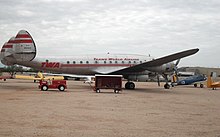
After breaking Pan American World Airways' legal designation as the United States' sole international carrier, TWA began trans-Atlantic service in 1946 using DC-4s and the elegant new Lockheed Constellation ("Connie"); soon its name was changed to The Trans World Airline. Flights reached Cairo in 1946, Bombay in January 1947, Ceylon in February 1953, and Manila in January 1958; two 1049Gs a week reached Manila 31–32 hours after leaving Idlewild. The route was cut back to Bangkok in a year or two and to Bombay in 1961. In 1966 it re-extended to Hong Kong via Bangkok, then in 1969 TWA opened the trans-Pacific link to complete its round the world network that lasted until 1975.

The airline assisted in the setting-up of Saudi Arabian Airlines, Ethiopian Airlines, and the newly established German national airline Lufthansa. Airlines from around the world sent their pilots to TWA for training.
Revenue passenger traffic (scheduled flights only, domestic plus international, in millions of passenger-miles): 1,875 in 1951, 3,477 in 1955, 5,490 in 1960, 10,225 in 1965, 18,599 in 1970, 20,957 in 1975.[8]
Falling Out Between Hughes and Frye
Frye and Hughes had a falling out in 1946. Hughes' financial advisor Noah Dietrich said that Frye was ruining the company with overexpansion. TWA's stock market price plunged from $53 a share to $10 as the airline suffered a pilot's strike and a temporary grounding of its Constellation fleet. Hughes dictated to management a 50% cut across the board as a solution to the financial problems. In December 1946, Hughes loaded the TWA Board of Directors with men from the Hughes Tool Co. Frye resigned in February 1947, followed three months later by Richter. Thus ended the era of "The Airline Run by Flyers."
Throughout the next two decades, TWA suffered constant changes in management, with the exception of Ralph Damon. TWA survived partly due to the airline's legal maneuvering of the 1940s that eliminated a possible competitive threat from American Overseas Airlines, affiliated with American Airlines. C.R. Smith, President of American, unhappy with the AOA's financial results, sold AOA to Pan American in 1950, leaving TWA and Pan Am as the only U.S. airlines that flew to Europe until the 1970s.
1950s—Trans World Airlines
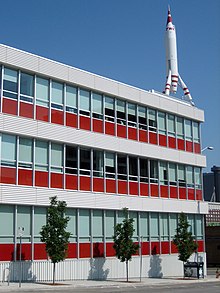
In 1950, the airline officially changed its name to Trans World Airlines. Between 1954 and 1958 it moved its executive offices from its landmark downtown Kansas City building to New York City. However, the servicing of the fleet continued to be handled in Kansas City, Kansas. Initially, servicing was at a former B-25 Mitchell bomber factory at Fairfax Airport. When the Great Flood of 1951 destroyed the facility, the city of Kansas City, Missouri built TWA a 5,000-acre (20 km2) airport on farmland 15 miles (24 km) north of downtown at what became Kansas City International Airport. At its peak, the airline was one of Kansas City's biggest employers with more than 20,000 employees. TWA also became well regarded by Hollywood movie stars and executives and became known as the "Airline To The Stars."
In the 1950s the TWA Moonliner was the tallest structure at Disneyland and depicted atomic-powered travel to come in 1986.

TWA suffered from its late entry to the jet age and in 1956 Hughes placed an order for 63 Convair 880s at a cost of $400 million. The transaction ultimately resulted in Hughes losing control of the airline because outside creditors financing the deal did not want Hughes controlling both development and operation of aircraft.
In 1958 TWA became the first major airline to hire an African-American flight attendant, hiring Margaret Grant after another African-American woman, Dorothy Franklin of Astoria, Queens, New York, filed a lawsuit alleging "that she had been discriminated against 'because of poor complexion ... unattractive teeth' and legs that were 'not shapely.'" New York governor W. Averell Harriman praised her hiring, saying the action "would raise American prestige abroad."[9]
1960s
On July 19, 1961, TWA was the first airline to introduce regular in-flight movies aboard its aircraft when it offered the feature film By Love Possessed, starring Lana Turner and Efrem Zimbalist, Jr. in the first-class section of a Boeing 707 during a scheduled flight from New York City to Los Angeles.
Charles C. Tillinghast Jr.
Hughes formally relinquished power in 1961 in the battle over the purchase of the Convair 880 jetliners. In the deal, Charles C. Tillinghast Jr. became chairman and oversaw the airline until 1976. The battle over Hughes' control continued until a court order in 1966 forced Hughes to sell his stock at a profit of $546 million (which he used to purchase the regional carrier Air West and rename the airline Hughes Airwest).
Under new corporate management, the Trans World Corporation (TWA's holding company) expanded to purchase the overseas operations of Hilton Hotels.
Revolutionary airport design
TWA was one of the first airlines in the world to embrace the spoke-hub distribution paradigm and also was one of the first airlines to use the Boeing 747. It planned to use the 747 along with the anticipated supersonic transport to whisk people between the West/Midwest (via Kansas City) and New York City (via John F. Kennedy International Airport) to European and other world destinations. As part of this strategy, TWA's hub airports were to be designed so that gates would be close to the street. However, the TWA-style airport design proved impractical and costly when Cuban hijackings in the late 1960s, followed by more sinister and deadly Mideast hijackings, required central security checkpoints.
John F. Kennedy International Airport
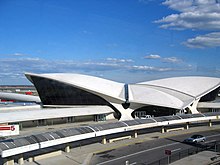
In 1962, TWA opened Trans World Flight Center, now known as Terminal 5 (or simply T5), at New York City's JFK Airport and designed by Eero Saarinen. The terminal was expanded in 1969 to accommodate Jumbo Jets, went dormant in 2001, and underwent renovation and expansion beginning in 2005. A new terminal with a crescent-shaped entry hall and now serving JetBlue Airways opened in 2008—partially encircling the historic landmark designed by Eero Saarinen.
Kansas City International Airport
Kansas City approved a $150 million bond issue for the TWA hub there. TWA vetoed plans for a Dulles International Airport-style hub-and-spoke gate structure. Following union strife, the airport ultimately cost $250 million when it opened in 1972, with U.S. Vice President Spiro Agnew officiating. TWA's gates, which were conceived of being within 100 feet (30 m) of the street, were likewise to become obsolete because of security issues. Kansas City refused to rebuild its terminals as Dallas-Fort Worth International Airport rebuilt its similarly designed terminals, forcing TWA to look for a new hub. Missouri politicians moved to keep it in the state, and in 1982, TWA began a decade-long move to Lambert International Airport in St. Louis, Missouri.
All-jet fleet
On April 7, 1967, TWA became one of the USA's first all-jet airlines with the retirement of their last Lockheed L-749A Constellation and L-1649 Starliner cargo aircraft. That morning throughout the TWA system, aircraft ground service personnel placed a booklet on every passenger seat titled "Props Are For Boats."
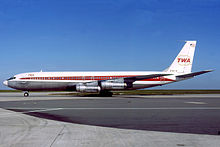
In 1967-72 TWA was the world's third-largest airline by passenger-miles, behind Aeroflot and United. In 1969 TWA carried the most transatlantic passengers of any airline; until then Pan American World Airways had always been number one. In the Transpacific Route Case of 1969 TWA was given authority to extend its route network across the Pacific to Hawaii and Taiwan.
In 1969 TWA opened the Breech Academy on a 25-acre (100,000 m2) campus in the Kansas City suburb of Overland Park, Kansas, to train its flight attendants, ticket agents, and travel agents, as well as to provide flight simulators for its pilots. It became the definitive airline facility, training other airlines staff as well as its own.
The airline continued to expand European operations through the 1960s, 1970s, and 1980s. In 1987 TWA could boast of a trans-Atlantic system that stretched from Los Angeles to Bombay, including virtually every major European population center, with ten gateways from the United States.
1970s
This section needs expansion. You can help by adding to it. (January 2011) |
In 1975, Trans World Airlines was headquartered in Turtle Bay area of Midtown Manhattan, New York City.[10][11] It is the site of the United Nations Headquarters and the Chrysler Building. [verification needed]
1980s
Facing the pressures of deregulation, the airline began to consolidate its route system around a domestic hub in Saint Louis (aided by its purchase of Ozark Air Lines in 1986) and an international gateway in New York. It was able to remain profitable during this time because of its good pre-deregulation route positioning and the relatively low costs of adapting its operations. In 1985, Carl Icahn bought the airline operations from the Trans World Corporation and appointed himself as chairman of the newly independent airline. Also in 1985, TWA closed their hub at Pittsburgh International Airport after nearly 20 years of a hub status.
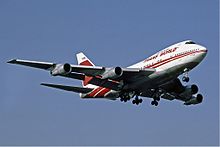
TWA had pilot bases in many European cities such as Berlin, Frankfurt, Zurich, Rome, and Athens. These bases were used to provide crews for the Boeing 727s which TWA operated in its European route network. Its Boeing 727 aircraft served Cairo, Athens, Rome, London, Paris, Geneva, Berlin, Frankfurt, Hamburg, Stuttgart, Zurich, Amsterdam, Vienna, and Istanbul.
In 1989 TWA decided to replace its fleet of Boeing 727 Series 100 aircraft with the former Ozark DC-9s. This decision was based on the economics of operating three-pilot airplanes (B-727s) with three engines, versus operating two-pilot airplanes (DC-9s) with two engines. Both airplanes had approximately the same passenger and cargo capacity, so it was decided to replace the Boeing fleet. In order to prepare for this transition, TWA positioned several million dollars worth of spare parts for the DC-9s in Germany. This was a requirement dictated by the German government. If TWA wanted to use DC-9s in the service of the German population, then TWA had to provide readily available spare parts for its fleet. The airline also sent its senior DC-9 pilots (known as Check Airmen) to Europe to observe the operations in preparation for the changeover of the crews that was to follow. Shortly before the DC-9 airplanes began arriving in Germany, however, the entire plan was canceled because the leasing contracts that Carl Icahn had created for the former Ozark DC-9s specifically forbade any operations outside of the continental limits of the United States.
In 1987 Icahn moved the company's main offices from Manhattan,[12] New York City to office buildings he owned in Mount Kisco.[13]

TWA's zenith occurred in the summer of 1988, when, for the only time, the airline would carry more than 50 percent of all trans-Atlantic passengers.[14] Every day, Boeing 747, Lockheed L-1011, and Boeing 767 aircraft would depart to more than 30 cities in Europe, fed by a small but effective domestic operation focused on moving U.S. passengers to New York or other gateway cities for widebody service across the Atlantic, while a similar inter-European operation would shuttle non-U.S. passengers to TWA's European gateways - London, Paris (which was even considered a European hub by TWA) and Frankfurt - for travel to the United States. Icahn's pressing needs for additional wealth forced him to sell the airline's Heathrow operations to American Airlines at about the same time that Pan American World Airways sold its Heathrow operation to United Airlines.
1990s
1992 bankruptcy
Tillinghast ignored the trans-Pacific market and the dedicated air cargo market. He was reported to have said, "There's no money in the Pacific and there's no money in cargo. We're gonna' shrink this airline 'til it's profitable." These two oversights are said to have been the undoing of TWA.
Airline deregulation hit TWA hard in the 1980s. TWA had badly neglected domestic U.S. expansion at a time when the newly deregulated domestic market was growing at an exponential rate. TWA's holding company, Trans World Corporation, spun off the airline, which then became starved for capital. The airline briefly considered selling itself to corporate raider Frank Lorenzo in the 1980s, but ended up selling to corporate raider Carl Icahn in 1985. Under Icahn's direction, many of its most profitable assets were sold to competitors, much to the detriment of TWA. Icahn was eventually ousted in 1993, though not before the airline was forced to file for bankruptcy in 1992. Icahn emerged unscathed. TWA moved its headquarters from Mt. Kisco to the former headquarters building of McDonnell Douglas in St. Louis soon after Icahn left.
1995 Bankruptcy
When Carl Icahn left in 1993, he arranged to have TWA give Karabu Corp., an entity he controlled, the rights to buy TWA tickets at 45 percent off published fares through September 2003. This was named "The Karabu Deal."[15] The ticket program agreement, which began on June 14, 1995, excluded tickets for travel which originated or terminated in St. Louis, Missouri. Tickets were subject to TWA's normal seat assignment and boarding pass rules and regulations, were non-assignable to any other carrier, and were non-endorsable. No commissions were paid to Karabu by TWA for tickets sold under the ticket program agreement.
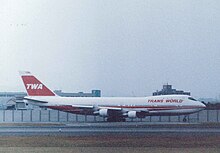
By agreement dated August 14, 1995, Lowestfare.com LLC, a wholly owned operating subsidiary of Karabu, was joined as a party to the ticket program agreement. Pursuant to the ticket program agreement, Lowestfare.com could purchase an unlimited number of system tickets. System tickets are tickets for all applicable classes of service which were purchased by Karabu from TWA at a 45 percent discount from TWA's published fare. In addition to system tickets, Lowestfare.com could also purchase domestic consolidator tickets, which are tickets issued at bulk fare rates and were limited to specified origin/destination city markets and did not permit the holder to modify or refund a purchased ticket. Karabu's purchase of domestic consolidator tickets was subject to a cap of $70 million per year based on the full retail price of the tickets.
On most TWA flights, Karabu could buy at a heavy discount and then sell a certain portion of all TWA's available seats. As a result, TWA was hamstrung by the high proportion of heavily discounted seats that had been pre-sold and was essentially left with no control over its own pricing. It could not afford to discount any of its own seats, and if TWA wanted to increase revenue on busy routes by putting a larger plane into service, Karabu would only claim more seats. It is estimated TWA was losing around $150 million a year in revenue with this deal.
In trying to ameliorate the Karabu deal, TWA went in and out of bankruptcy in 1995.
TWA Flight 800
On July 17, 1996, TWA Flight 800 exploded over the Atlantic Ocean near Long Island, killing all 230 people on board. The National Transportation Safety Board concluded that the most likely cause of the disaster was a center fuel tank explosion sparked by exposed wiring. In their subsequent coverage, the media focused heavily on the fact that TWA's airline fleet was among the oldest in service. The flight was under the command of Captain Steven Snyder, a veteran TWA pilot.
Short turn-around
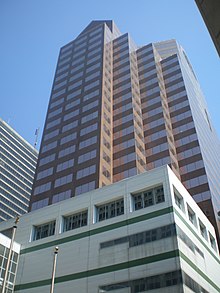
By 1998, TWA had reorganized as a primarily domestic carrier, with routes centered on hubs at St. Louis and New York. Partly in response to TWA Flight 800 and the age of its fleet, TWA announced a major fleet renewal, ordering 125 new aircraft. TWA paid for naming rights for the new Trans World Dome, home of the St. Louis Rams, in its corporate hometown.[citation needed] In June 1994 its headquarters moved to One City Centre in Downtown St. Louis.[16][17]
TWA's fleet renewal program included adding newer and smaller, more fuel-efficient longer-range aircraft such as the Boeing 757 and 767 and short-range aircraft such as the McDonnell Douglas MD-80 and Boeing 717. Aircraft such as the Boeing 727 and 747, along with the Lockheed L-1011 and older DC-9s, some from Ozark and the 1960s, were retired. TWA also became one of the early customers for the Airbus A318 through International Lease Finance Corporation (ILFC). TWA, had it continued operating through 2003, would have been the first U.S. carrier to fly the type.[citation needed]
International code-share agreements with Royal Jordanian Airlines, Kuwait Airways, Royal Air Maroc, Air Europa, and Air Malta. Domestic code-share with America West Airlines was started, with long-term plans for a merger considered. However, the 1995 Karabu ticketing deal with Icahn proved to be an obstacle.[citation needed]
The routes that TWA flew were also changed. Several international destinations were dropped or changed, and the focus of the airline became domestic and a small number of international routes through its St. Louis hub and smaller New York (JFK) and San Juan, Puerto Rico hubs. Domestically, the carrier improved services with redesigned aircraft and new services, including "Pay in Coach, Fly in First," where passengers could be upgraded to first class from coach when flying through St. Louis. Internationally, services were cut. European destinations eventually were limited to London, and Paris; and in the Middle East, to Cairo, Riyadh, and Tel Aviv.[citation needed]
2000s

TWA stated that it planned to make Los Angeles a focus city around October 2000, with a partnership with American Eagle Airlines as part of Trans World Connection.[18]
Merger with American Airlines
Financial problems began to resurface shortly afterward, and Trans World Airlines Inc. assets were acquired in April 2001 by AMR Corp., the parent company of American Airlines, who quickly formed a new company called TWA Airlines LLC. As part of the deal, TWA declared Chapter 11 bankruptcy (for the third time) the day after it agreed to the purchase. The terms of the deal included a $500 million payment. However, since American assumed TWA's liabilities, the deal was estimated to have cost American $2 billion.[19] American did not claim the naming rights for the Rams' home, which eventually became the Edward Jones Dome, named after the financial services company with the same name.
TWA booking ended on November 30, 2001.[20]
TWA Airlines LLC flew its last flight on December 1, 2001 with an MD-80 aircraft (N948TW). The ceremonial last flight was Flight 220 from Kansas City, Missouri, to St. Louis, with CEO Captain William Compton at the controls. The final flight before TWA officially became part of American Airlines was completed between St. Louis and Las Vegas, Nevada, also on December 1, 2001. At 10:00 p.m. CST on that date, employees began removing all TWA signs and placards from airports around the country, replacing them with American Airlines signs. At midnight, all TWA flights officially became listed as American Airlines flights. Some aircraft carried hybrid American/TWA livery during the transition, with American's tricolor stripe on the fuselage and TWA titles on the tail and forward fuselage. Signage still bears the TWA logo in portions of Concourse D at Lambert St. Louis International Airport. On some MD-80 aircraft, the cabinets retain TWA logos.
American Airlines acquired some Ambassadors Clubs, and other Ambassadors Clubs closed on December 2, 2001.[21]
One lighted TWA sign still exists (as of 2011) on the east side of Saarinen's New York JFK terminal. According to David Barger, CEO of JetBlue Airways, JetBlue intends to retain the lit TWA sign on the Saarinen terminal after the renovation of Terminal 5.
TWA's St. Louis hub decreased after the merger due to its proximity to American's larger hub at Chicago's O'Hare International Airport. As a result, American initially replaced TWA's St. Louis mainline hub with regional jet service (going from over 800 operations a day to just over 200) and downsized TWA's maintenance base in Kansas City. In September 2009, American Airlines announced its intent to shut down the STL hub it inherited from TWA, and in October 2009, American Airlines announced its intent to close the Kansas City maintenance base by September 2010.
Destinations
See TWA destinations for mainline destinations. For commuter destinations, see Trans World Express and Trans World Connection.
TWA had codeshare agreements with the following airlines:
Accidents and Incidents
Terrorist target
From 1969 to 1986, five TWA airliners were terrorist targets for Palestinian guerrilla groups, four of which were hijackings and two bombings, mainly because the airline had a strong European presence, was a flag carrier for the United States of America, and flew to Israel.
- In 1969, TWA Flight 840 from Rome to Athens was hijacked and forcibly diverted to Damascus. Nobody was injured, but the aircraft's nose was blown up (although replaced and the plane returned to service).
- In 1970, TWA Flight 741 was hijacked after taking off from Frankfurt am Main, Germany, to New York. It was taken to Dawson's Field in Jordan with two other hijacked aircraft. All three aircraft were empty of passengers and crew before being destroyed. A fourth aircraft that landed in Cairo, Egypt, suffered a similar fate.
- In 1971, Three members of the group "Republic of New Afrika" who had murdered a New Mexico State Policeman on November 8 hijacked TWA Flight 106, a Boeing 727, from Albuquerque to Havana. Passengers were released in Tampa.
- In 1974, TWA Flight 841 from Tel Aviv to New York City crashed shortly after takeoff from Athens en route to Rome after a bomb believed to have been in the cargo hold exploded, killing all 88 on board.
- In 1976, TWA Flight 355 was hijacked by five Croatian separatists as it flew from New York–LaGuardia to Chicago. They ordered the pilot to fly to Montreal, where the plane was refueled, and then made additional refueling stops in Gander and Keflavik; at some of these stops, the hijackers unloaded propaganda pamphlets that they demanded to be dropped over Montreal, Chicago, New York, London, and Paris. At the plane's final stop at Paris-Charles de Gaulle, the hijackers surrendered after direct talks with U.S. ambassador Kenneth Rush, and their explosives were revealed to be fakes.[22][23]
- In 1985, TWA Flight 847 from Athens to Rome was hijacked first to Beirut, then to Algiers, back to Beirut, back to Algiers, and finally back to Beirut—with some of its fuel being paid for by the Shell credit card of flight attendant Uli Derickson. United States Navy Petty Officer 2nd Class Robert Stethem was singled out by Hezbollah as a member of the American military. The hijackers beat and tortured Stethem, Mohammed Ali Hammadi murdered the dying sailor and dumped his body on the tarmac. Robert Stethem was awarded the Purple Heart and Bronze Star with burial in Arlington National Cemetery. The memory of Robert Dean Stethem is honored by his nation in the USS Stethem (DDG-63).
- In 1986, TWA Flight 840 was attacked with an on-board bomb causing four Americans (including a nine-month-old infant) to be ejected from the aircraft to their deaths. Five others on the aircraft were injured as the cabin experienced a rapid decompression. The remaining 110 passengers survived the incident as pilot Richard "Pete" Petersen made an emergency landing.
Fleet
Fleet
| Aircraft | Total | Orders | Notes |
|---|---|---|---|
| Airbus A318-100 | 0 | 50 | Order cancelled. |
| Boeing 757-200 | 27 | 0 | 17 currently operated by Delta Air Lines. Others in service with Ethiopian Airlines, Blue Panorama Airlines and Uzbekistan Airways. |
| Boeing 767-200ER | 12 | 0 | Aircraft 16001 has been scrapped and the E&E section is used for Avionics training at Boeing's Everett maintenance facility. If you're there to see the assembly of Widebody Aircraft, you can see the lower half with the same White & Red stripe. |
| Boeing 767-300ER | 10 | 0 | |
| McDonnell Douglas MD-81 | 8 | 0 | |
| McDonnell Douglas MD-82 | 38 | 0 | 21 remain in service with American Airlines. |
| McDonnell Douglas MD-83 | 65 | 0 | 57 remain in service with American Airlines. |
| Boeing 747-200B | 2 | 0 | |
| Boeing 717 | 30 | 20 | Majority were later sold to AirTran Airways while others went to other carriers. The remaining 20 on order were cancelled. |
| Total | 192 | 70 |
Retired fleet
| Type | Years | Routes | Notes |
|---|---|---|---|
| Douglas DC-1 | 1933–1934 | Operated the one & only DC-1 built. | |
| Douglas DC-2 | 1934–1942 | Operated 31. | |
| Douglas DC-3/C-47 | 1937–1957 | Operated 104. | |
| Martin 4-0-4 | 1950-1961 | Operated 40. | |
| Boeing 707-120/-320 | 1960–1983 | Operated 56 -131s, 3 -124s, 65 -331s & 2 -373s. | |
| Boeing 727-100 | 1964-1993 | Operated 35 -100s. | |
| Boeing 727-200 | 1968–2000 | Operated 61 -200s. | |
| Boeing 747-100/-200 | 1970–2000 | Operated 19 -131s, 6 used -100s & 5 used -200s. | |
| Douglas DC-9-14/-15/-41/-51 | 1967–1999 | Operated 6 -14s, 21 -15s, 3 -41s & 12 -51s. | |
| Boeing 747SP | 1979–1986 | Operated 3 total. | |
| Convair 880 | 1960–1974 | Operated 28 total. | |
| Lockheed L-1011 | 1972–1997 | Operated 41 total. | |
| Lockheed Constellation | 1945–1967 | Received first 40. |
TWA at one time also held orders for the BAC-Aérospatiale Concorde, Sud Aviation Caravelle, Boeing 2707, and the Airbus A330 (which were taken by Cathay Pacific). The A330 order was eventually converted to A318 orders.
Fleet in 1970
| Aircraft | Total | Orders | Notes |
|---|---|---|---|
| BAC/Sud Concorde | Six on option | ||
| Boeing SST | 12 on option | ||
| Boeing 707-120 | 58 | ||
| Boeing 707-320 | 49 | ||
| Boeing 707-320C | 14 | ||
| Boeing 727-100 | 27 | ||
| Boeing 727-100QC | 8 | ||
| Boeing 727-200 | 32 | ||
| Boeing 747 | 3 | 12 | |
| Convair CV-880 | 25 | ||
| Douglas DC-9-15 | 19 | ||
| Lockheed L-1011 TriStar | 22 | ||
| Total | 225 | 34 |
Crew bases
TWA had crew bases in Boston, New York, Washington DC, St Louis, Kansas City, Chicago, San Francisco, Los Angeles, and Frankfurt. international flight attendants crew bases were located in Paris,Rome, Hong Kong and at one time, Cairo. Starting in 1996, TWA had a "West Coast Regional Domicile," in which pilots and flight attendants covered originating flights out of major west coast U.S. airports from San Diego, CA north to San Francisco, CA.[25] agreements between SNPNC F/A Union (Paris) and TWA until airline stopped
Ambassadors Club
TWA operated Ambassadors Club locations in various airports. American Airlines acquired some clubs, and other clubs closed on December 2, 2001.[21] Before the closure of the clubs, TWA maintained clubs at the following airports:
Clubs in North America open on December 1, 2001
 United States
United States
- California
- Los Angeles (Los Angeles International Airport) (Converted into Alaska Airlines Board Room)[27]
- San Francisco (San Francisco International Airport) (Converted into Alaska Airlines Board Room)[27]
- Massachusetts
- Missouri
- Kansas City (Kansas City International Airport) (Converted into Admirals Club [21])
- St. Louis (Lambert-St. Louis International Airport) (Converted into Admirals Club [21])
- New York
- Virginia
- California
Clubs in North America closed prior to dissolution
Clubs in Europe closed prior to dissolution
See also
References
- ^ Atlanta hub closing article retrieved 9-30-08
- ^ Atlanta hub opening article retrieved 9-30-08
- ^ The airline business By Rigas Doganis
- ^ TWA's flight ends as it merges into American
- ^ Ailing T.W.A. Still a Symbol, and So Perhaps a Target, Abroad
- ^
"Transport:TWA Trippers". Time Magazine. 103 (20). Time Inc. November 15, 1937. Retrieved 3/11/2011.
{{cite journal}}: Check date values in:|accessdate=(help) - ^ a b International Directory of Company Histories, Vol. 35. St. James Press, 2001 - via Fundinguniverse.com
- ^ Handbook of Airline Statistics (biannual CAB publication)
- ^ INS. "First negro hostess hired by TWA," The Bridgeport Post, Bridgeport, Connecticut, February 10, 1958, page 26.
- ^ World Airline Directory. Flight International. March 20, 1975. "508.
- ^ "Map." Turtle Bay Association. Retrieved on January 25, 2009.
- ^ "World Airline Directory". Flight International. March 30, 1985. 128." Retrieved on June 17, 2009.
- ^ Brown, Betsy (1987-07-19). "Mount Kisco Awaits Arrival of T.W.A." The New York Times. Retrieved 2009-01-05.
- ^ The table in Air Transport World for June 1989 says in 1988 TWA had fewer "Atlantic" passenger-miles than Pan Am alone.
- ^ Sample Contracts - Karabu Ticket Program Agreement - Trans World Airlines Inc. and Karabu Corp. - Competitive Intelligence for Investors
- ^ "Contact TWA." Trans World Airlines. May 1, 1999. Retrieved on May 18, 2009.
- ^ Brown, Lisa R. "Lewis Rice eyes move to One City Centre." St. Louis Business Journal. Friday July 10, 2009. Retrieved on August 18, 2009.
- ^ "LOS ANGELES IS TWA'S 2000 FOCUS CITY." Trans World Airlines. August 15, 2000. Retrieved on July 25, 2009.
- ^ "American-TWA merger could hurt isles". Honolulu Star-Bulletin. 2001-01-08. Retrieved 2009-02-09.
- ^ Home Page," Trans World Airlines
- ^ a b c d e "TWA Ambassadors Club," Trans World Airlines
- ^ Bombs for Croatia (Part I)
- ^ Bombs for Croatia (Part II)
- ^ Flight International 26 March 1970
- ^ 1996 Working Agreement between Trans World Airlines and (sic) Pilots Represented by the Air Line Pilot's Association in their service: Section 6, pages 16–18.
- ^ "View Domestic Locations," Trans World Airlines
- ^ a b TWA
- ^ "TWA North America Destinations," Trans World Airlines
- ^ "TWA Transatlantic Destinations Europe and the Middle East," Trans World Airlines
External links
- Template:Wayback
- [1] has many TWA timetables from 1931 until 1968, showing where they flew, how long it took and how much it cost.
- TWAlive
- TWA History - TWA Official Website
- The karabu deal contract
- Historical aircraft images, market survey, & overview
- Airlines disestablished in 2001
- Airlines established in 1930
- American Airlines
- Companies based in Kansas City, Missouri
- Companies based in St. Louis, Missouri
- Companies that have filed for Chapter 11 bankruptcy
- Defunct airlines of the United States
- Defunct companies based in Missouri
- Former IATA members
- Howard Hughes
- Trans World Airlines
- Defunct companies based in New York City
